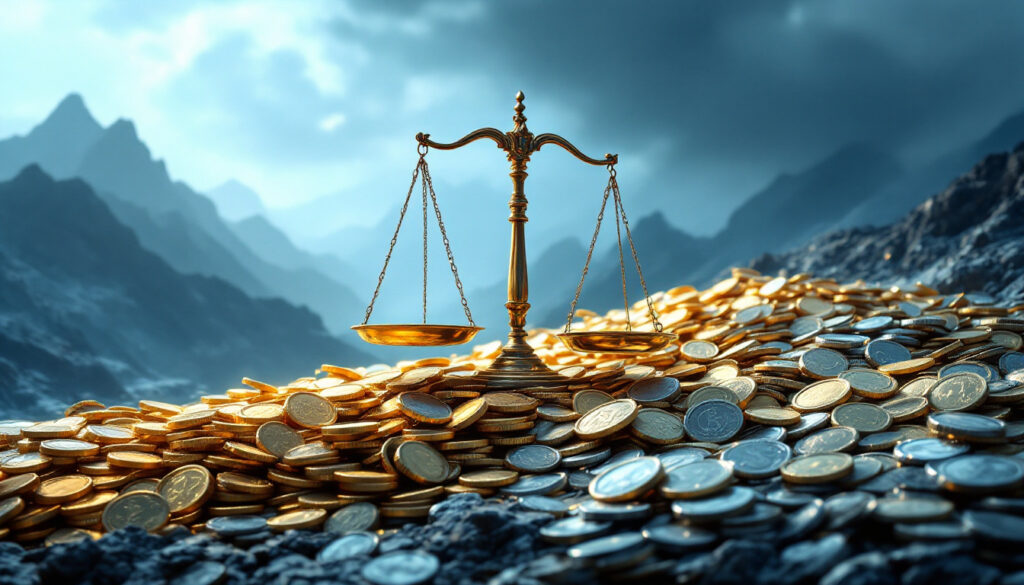What is the Gold to Silver Ratio?
Definition and Calculation
The gold to silver ratio represents the number of silver ounces required to purchase one ounce of gold, calculated by dividing the spot price of gold by that of silver. For instance, if gold trades at $2,000 per ounce and silver at $25, the GSR is 80:1. This metric functions as a relative value indicator, enabling investors to compare the two metals' performance over time. Unlike absolute price movements, the GSR reveals shifts in market preference between these assets, reflecting broader economic conditions such as inflation expectations or risk appetite. Understanding the gold and silver ratio is essential for investors seeking to optimize their precious metals portfolio.
Historical Context and Significance
Patrick Kim, a market analyst, describes the GSR as a "Rosetta Stone" for interpreting macroeconomic trends. Historically, the ratio averaged 15:1 over centuries due to natural geological abundance ratios, but modern financialization and industrial demand for silver have increased its volatility. For example, during the 2008 financial crisis, the GSR surged to 84:1 as investors flocked to gold, while post-crisis recovery saw it drop to 30:1 by 2011 during silver's rally. These fluctuations underscore its dual role as both a tactical trading tool and a macroeconomic signal. Furthermore, historical metals trends show consistent patterns that help predict future movements.
How Does the Gold to Silver Ratio Work as a Market Indicator?
Interpreting Ratio Movements
A declining GSR signals silver outperforming gold, typically associated with risk-on environments where industrial demand and economic growth boost silver. Conversely, a rising ratio indicates gold's relative strength, often during risk-off periods marked by market uncertainty or deflationary pressures. As of 2025, the GSR exhibits higher highs and higher lows—a pattern last seen before the 2020 crash—suggesting accelerating risk aversion. For instance, the ratio's upward breakout in March 2020 preceded a 34% S&P 500 decline within weeks. Recent gold market analysis confirms these patterns are continuing to hold true.
Correlation with Economic Cycles
The GSR's predictive power stems from its alignment with business cycles. Analysis of U.S. recessions since 1970 shows the ratio spiking 6–12 months before GDP contractions. During the 2000 dot-com bubble, the GSR rose from 60:1 to 80:1 as equities peaked, foreshadowing a three-year bear market. Similarly, its 2020 surge to 127:1—a record high—coincided with the fastest equity selloff in history. These correlations make it a valuable component of a "weight of evidence" approach to market analysis, as noted by Kim. According to the historical guide to the gold-silver ratio, these patterns have remained consistent for centuries.
What Can the Gold-Silver Ratio Tell Us About Recessions?
Historical Evidence from Major Market Events
The GSR has provided early warnings for every U.S. recession since 1980. In 2007, the ratio bottomed at 45:1 before soaring to 84:1 during the 2008 crisis, reflecting gold's safe-haven demand as credit markets froze. Similarly, its 2020 ascent began in late 2019, anticipating COVID-19's economic impact months before lockdowns. These precedents highlight its utility as a leading indicator, though analysts caution against relying on it in isolation. Current metals market trends suggest similar patterns may be developing now.
Early Warning System Properties
Gold's historical resilience during crises explains the GSR's predictive accuracy. Between 2007 and 2009, gold prices rose 25% while silver fell 9%, driving the ratio upward. This dynamic reflects gold's role as a monetary metal versus silver's industrial ties, which account for 50% of its demand in sectors like solar panels and electronics. When the ratio trends upward, it signals eroding confidence in growth-sensitive assets, often preceding equity market corrections. The gold-silver ratio chart provides visual confirmation of these historical patterns.
How Can Investors Use the Gold-Silver Ratio?
Tactical Asset Allocation Strategy
Extreme GSR levels signal contrarian opportunities. At ratios above 80:1—seen in 1991, 2008, and 2020—switching from gold to silver has historically generated outsized returns. For example, investors who reallocated during the 2008 peak (84:1) captured silver's 400% rally to $49/oz by 2011. Current ratios near 90:1 (as of April 2025) suggest similar potential, though Kim emphasizes waiting for a confirmed downtrend before entering silver. Many investors are incorporating these insights into their gold ETFs strategies for balanced exposure.
Timing Silver Investments
Silver's strongest rallies occur after the GSR peaks and reverses. Post-2008, the ratio's decline from 84:1 to 30:1 coincided with silver's rise from $9 to $49. Similarly, the 2020–2021 drop from 127:1 to 60:1 saw silver surge from $12 to $29. These periods, described by analysts as "mind-boggling moves," underscore the importance of patience in awaiting technical confirmation. The latest gold market outlook suggests we may be approaching another inflection point.
What Technical Patterns Should Investors Watch in the Ratio?
Key Chart Formations
The GSR's current structure mirrors pre-2008 and pre-2020 patterns, with a series of higher highs (95:1 in 2024 vs. 90:1 in 2023) and higher lows (75:1 vs. 70:1). A breakout above the 2020 high of 127:1 would signal intensifying risk aversion, while a breakdown below 80:1 could indicate economic stabilization. Analysts monitor moving averages and momentum indicators like the MACD for trend confirmation.
Comparative Chart Analysis
Overlaying the GSR with silver prices reveals an inverse correlation. The 2011 silver peak ($49/oz) aligned with the ratio's trough (30:1), while the 2020 COVID low ($12) matched its zenith (127:1). This relationship helps identify potential inflection points, particularly when silver tests long-term support levels during ratio spikes.
Why Does Silver Outperform After Market Bottoms?
Dual Nature of Silver
Silver's dual role as an industrial and monetary metal amplifies its volatility. Post-recession, rebounding manufacturing activity boosts industrial demand, while loose monetary policies lift precious metals broadly. For instance, post-2008 stimulus programs drove silver's 2010–2011 rally, with industrial demand growing 20% annually alongside record investment inflows.
Historical Performance Patterns
After the 2003 market bottom, silver rose 90% in two years as the GSR fell from 80:1 to 60:1. Similarly, its 2020–2021 surge followed unprecedented fiscal and monetary expansion, with global silver demand hitting 1.05 billion ounces in 2021. These cycles demonstrate silver's leverage to economic recoveries, often delivering multiples of gold's returns.
FAQ About the Gold-Silver Ratio
What is considered a "high" gold-silver ratio historically?
Ratios above 80:1 are historically elevated, with extremes like 127:1 (2020) signaling panic. The long-term average of 15:1 reflects pre-industrial scarcity, but modern financial markets stabilize around 50:1–60:1 outside crises.
How reliable is the gold-silver ratio as a recession indicator?
While not infallible, the GSR has preceded every U.S. recession since 1970 by 6–18 months. Analysts recommend combining it with yield curve data and PMI trends for confirmation.
When is the optimal time to switch from gold to silver?
Post-recession, when the GSR begins declining from peaks (e.g., 2009 and 2020), offers the highest probability of success. Technical indicators like RSI divergence and moving average crossovers help identify reversals.
Current Market Implications and Future Outlook
Present Ratio Analysis
The GSR's consolidation near 90:1 (April 2025) suggests persistent risk aversion, exacerbated by geopolitical tensions and slowing global growth. However, silver's undervaluation relative to gold—highlighted by its 50% discount to the 50-year average ratio—creates asymmetric upside potential post-recession.
Potential Investment Strategy
Investors should maintain defensive allocations to gold while monitoring the gold and silver ratio for breakout signals. A close below 80:1 would indicate silver's resurgence, potentially marking the start of a "generational move" akin to 2009–2011. Until then, staggered entries into physical silver or miners offer a balance between risk and reward.
"What you got what we're witnessing right now Kevin is actually the setup to the generational move in silver… where silver is going to go from wherever and double triple quadruple up… we have to wait until the markets really enter a bare market bottom and once that GSR starts unwinding my goodness that's silver is going to probably be the best instrument to own there for the next years."
Ready to Catch the Next Major Mining Discovery?
Discover how to gain immediate, real-time alerts on significant ASX mineral discoveries with Discovery Alert's proprietary Discovery IQ model, helping you identify investment opportunities before the broader market. Visit Discovery Alert's dedicated discoveries page to understand how historic discoveries have generated substantial returns and begin your 30-day free trial today.




